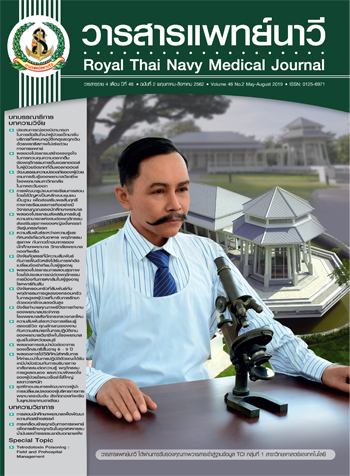The Development of a Transformational Leadership Training Set for Primary Nursing Administrations under the Royal Thai Navy in the ASEAN Economic Community
Main Article Content
Abstract
The purpose of this research was to (1) study the necessary transformational leadership of primary nursing administrators under the Royal Thai Navy in the ASEAN Economic Community, (2) develop training set for transformational leadership development, and (3) evaluate training set. Developed research in the form of research and development. The sample used in this study was operational experts academic/ educational and management number of 18 persons. The experts were selected by purposive sampling to find the required transformational leadership of primary nursing administrators using Delphi technique. To develop training set and evaluate the training sets developed. The experiment was conducted with 30 primary nursing administrators. The data were as collected by questionnaire. The statistics used in the analysis were: mean, standard deviation, paired simple t-test. The results were as follow: (1) the necessary transformational leadership of primary nursing administrators under the Royal Thai Navy in the ASEAN economic community, consists of 5 aspects: management, social teamwork and cross-cultural learning, self-development, In the use of information technology communication and English and professional standards (2) development of training set for transformational leadership for primary nursing administrations under the Royal Thai Navy in the ASEAN economic as overall is the most appropriate. When considering each aspect, it was found that it was appropriate at the highest level in all aspects. Training sets are consistent across all elements. It is appropriate and can be used. (3) Evaluating the effectiveness of the training sets, found that the transformational leadership scores of the primary nursing administrators after training were higher than those before training in all aspects. Self-assessment scores of participants after the experiment were higher than those before the experiment in the overall and each aspect. Trainers still maintain knowledge after training. The scores assessed by supervisors before and after 12 weeks of training showed that after the training, it was higher than before training in all aspects. The satisfaction of the trainees to the training was at the highest level. It confirms the effective and suitable for use of the training set.
Article Details

This work is licensed under a Creative Commons Attribution-NonCommercial-NoDerivatives 4.0 International License.
References
2. Santad P. Leadership and human resource development in preparing to join the ASEAN community. Journal of Quality of Life and Law 2012;8(2):15-26. (in Thai).
3. Bass BM. Two decades of research and development in transformation leadership. European Journal of World and Organization Psychology1999;8(1):9-32.
4. Nursing Office. Nursing service strategy for the ASEAN community. [Internet]. [cited 2015 March 20]. Available from: http: //www.nursing.go.th/? Page_id = 214. (in Thai).
5. Bass BM, Avolio BJ. Improving organizational effectiveness through transformational leadership. Newbery Park, CA: Sage; 1994. p. 33.
6. Welch JJ. The leadership style of the Massachusetts school superintendents. Dissertation Abstracts International 1982;43(2):335–A.
7. Fullan M. Change theory: a force for school improvement, in The Development of Transformational Leaders for the Educational Decentralization. Bangkok: Ministry of Education; 2006.
8. Joo BK, Yoon HJ, Jeung CW. The effects of core self-evaluations and transformational leadership on organizational commitment. Leadership & Organization Development Journal 2012;33(6):564-82.
9. Polychroniou PV. Relationship between emotional intelligence and transformational leadership of supervisors. Team Performance Management 2009;15(7/8):343-56.
10. Fitzgerald S, Schutte N. Increasing transformational leadership through enhancing self-efficacy. Journal of Management Development 2010;29(5):495-505.
11. Bass BM, Avolio BJ. The full range model of leadership. New York: McGraw-Hill; 1991.
12. Crawford CB. Effects of transformational leadership and organizational position on knowledge management. Journal of Knowledge Management 2005;9(6):6-16.
13. Guay RP. The relationship between leader fit and transformational leadership. Journal of Managerial Psychology 2013;28(1):55-73.
14. Bonzarth J. From analysis to evaluation: tools, tip, and techniques for trainers. New York: John Wiley & Sons; 2008.
15. Knowles MS. The adult learner: the definition classic in adult education and human resource development. USA: Elsevier; 2011.
16. Traipat P. Transformational leadership development of nursing unit heads in hospitals under jurisdiction of the Ministry of Defense by using the contemplative education. Royal Thai Navy Medical Journal 2016;43(1):17-32. (in Thai).
17. Nakbun C. Development of training courses to enhance the leadership change characteristics of supervisors for electronic industry business organizations. [Doctoral Dissertation, Human Resource Development]. Ramkhamhaeng University; 2015. (in Thai).
18. Kirkpatrick DL. Evaluating training programs: the four levels. 2nd ed. San Francisco: Berrett-Koehler; 1994.
19. Tannukit P. Development of competency training sets for primary nursing administrators at hospitals under the jurisdiction of the Medical Office Bangkok. [Doctoral Dissertation, Human Resource Development]. Ramkhamhaeng University; 2013. (in Thai).


